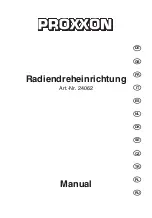
10
7. Unscrew stop bolt from Lathe bed (Figure 6-6),
and screw it into hole at end of bed extension.
For outboard turning, where headstock is moved to
opposite end of Lathe to accommodate large bowl
blanks, the 20” bed extension can be mounted to the
four lower holes on Lathe frame. Install the
extension post (included with optional bed
extension) into the tool rest base. See Figure 6-7.
For large outboard work, an optional outboard
turning stand (# 6294732) is available – see
sect.
16.4.1.
Figure 6-7: outboard turning accessories
6.6
User-made shelf (optional)
The double ledges on the inside of the Lathe legs
provide support for a shelf (not provided), which is
convenient for storing larger items while keeping
them easily accessible.
Figures 6-8 through 6-10 illustrate three methods of
creating a shelf, using common lumber and basic
tools.
IMPORTANT TIP
: It is unlikely that a full-size shelf
can be completely built and then inserted between
the Lathe legs. Therefore, construct the shelf in
pieces and insert screws only
after
the shelf has
been established beneath the Lathe.
Shelf Style 1
(Figure 6-8)
Lay two 2x6 boards flat upon the inner ledges.
Boards of 49” length are suitable, although 49-1/2”
is optimal. Or, use 48” boards and place shim stock
on the ledges at each end to prevent shifting.
Shelf Style 2
(Figure 6-9)
Lay two 2x4 (or 2x6) boards on edge into the outer
ledges. Boards of 49” length are suitable, 49-1/2”
optimal.
Cut two pieces from a plywood board, and screw
them to the top edges of the 2x4’s. (One full length
plywood piece will not fit through the legs of the
Lathe; use at least two pieces.) Make the plywood
pieces flush with the outside edge of the 2x4’s.
Figure 6-8
Figure 6-9
Shelf Style 3:
(Figure 6-10)
This is a basket-style shelf consisting of two 2x6’s
and dowel rods. The advantage of this design is that
most wood chips will fall through the shelf instead of
accumulating on it.
Materials used:
2 – 2x6 boards (49” suitable, 49-1/2” optimal).
8 – wood dowels of 4’ length, 5/8” diameter.
1. Mark your hole centers (2” centers) along the
length of a 2x6. Place the holes so that the tops
of the dowels will be even with the tops of the
ledges on the Lathe. Also, adjust your hole
centers as necessary so that the first and last
dowel will begin at approximately the same
distance from the ledge at both ends of the
Lathe.
2. Use a 5/8” spade bit chucked in a drill press or
in a portable drill. Bore the holes
through
one
2x6; this will be the rear piece.
3. On the other 2x6, do not bore through but only
deep enough to securely hold the ends of the
dowel rods. This will be the front piece and will
provide a pleasing appearance at the front of
your Lathe.
4. When all holes have been bored, place the
2x6’s on edge in the outer ledges of the Lathe.
Summary of Contents for 3520C
Page 27: ...27 15 1 1 3520C Headstock Assembly Exploded View ...
Page 32: ...32 15 4 1 Bed Banjo and Tailstock Assembly Exploded View ...
Page 38: ...38 15 9 1 Optional Accessories 6294901 Lamp Holder Set exploded view ...
Page 40: ...40 16 0 Electrical connections for 1353001 3520C Lathe 16 1 Wiring diagram 1 of 2 ...
Page 41: ...41 16 2 Wiring diagram 2 of 2 B2 B1 U V W S L2 R L1 1 3 2 4 ...
Page 43: ...43 This page intentionally left blank ...
Page 44: ...44 427 New Sanford Road LaVergne Tennessee 37086 Phone 800 274 6848 www powermatic com ...






























